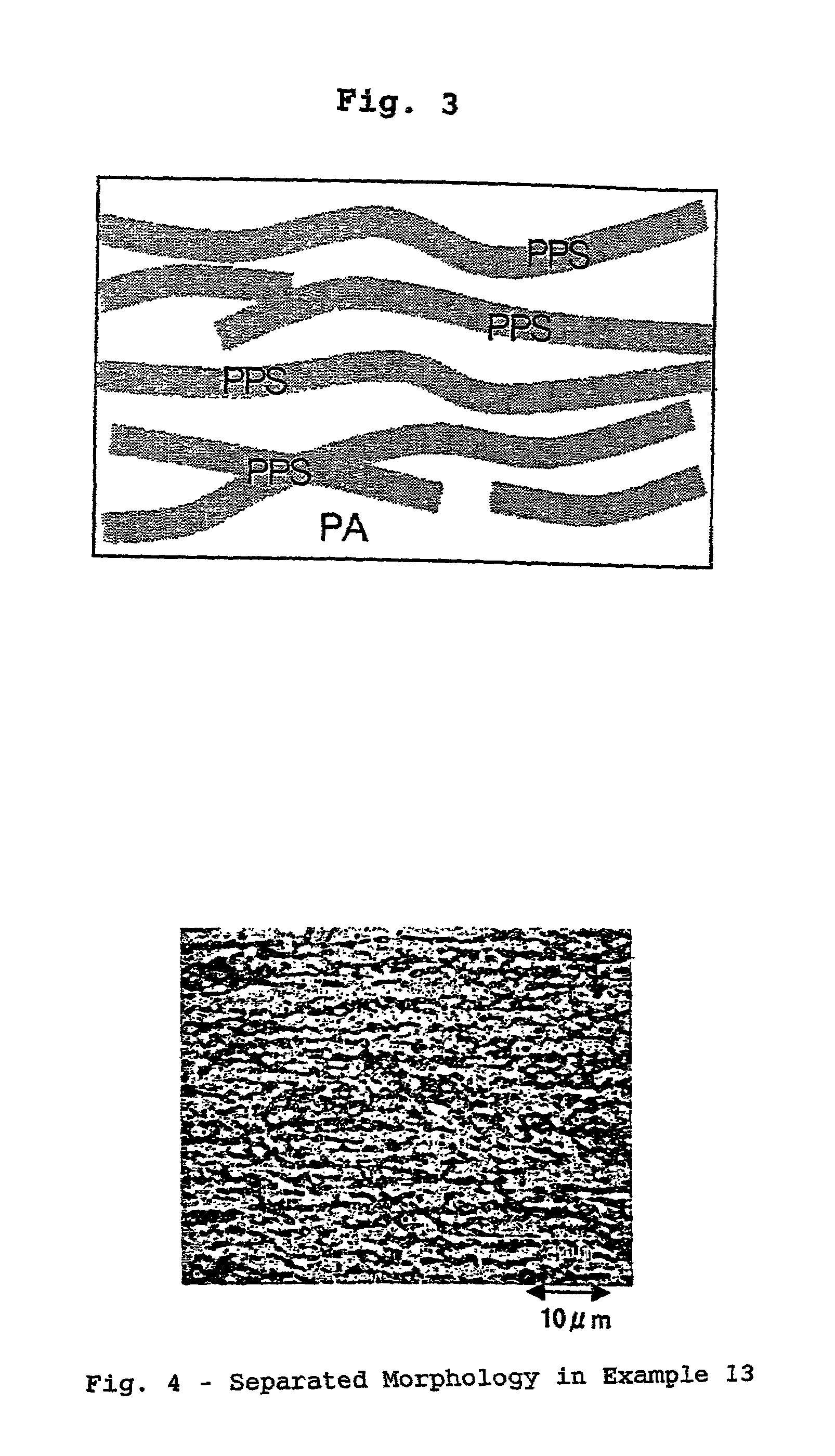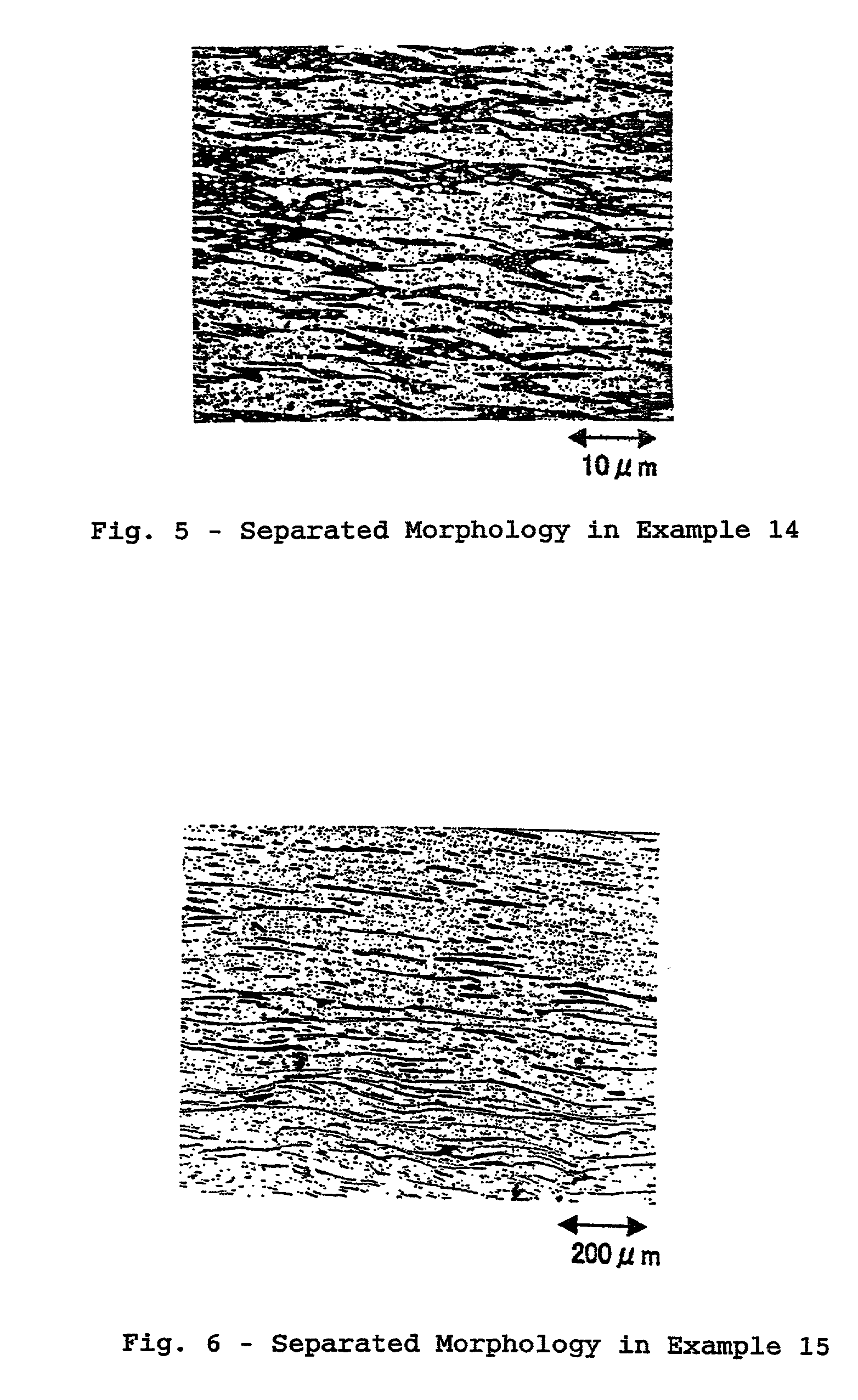Resin structure and use thereof
a thermoplastic resin and resin structure technology, applied in the direction of synthetic resin layered products, chemistry apparatus and processes, transportation and packaging, etc., can solve the problems of reduced dimensional stability and stiffness of polyamide resins, reduced production efficiency, and reduced use efficiency of polyamide resins, so as to enhance the productivity and industrial application of invention, good gas barrier properties, and easy to work durable
- Summary
- Abstract
- Description
- Claims
- Application Information
AI Technical Summary
Benefits of technology
Problems solved by technology
Method used
Image
Examples
reference example 1
Preparation of PPS Copolymer
[0101]3.26 kg of sodium sulfide (25 mols, containing 40% crystal water), 4 g of sodium hydroxide, 1.36 kg of sodium acetate trihydrate (about 10 mols), and 7.9 kg of N-methylpyrrolidone were fed into an autoclave equipped with a stirrer, and gradually heated up to 205° C. with stirring, and about 1.5 liters of distillate containing 1.36 kg of water was removed. To the residual mixture, added were 3.38 kg of 1,4-dichlorobenzene 4 (23.0 mols), 0.37 kg of 1,3-dichlorobenzene (2.5 mols), and 2 kg of NMP, and heated at 265° C. for 5 hours. The reaction product washed three times with hot water at 70° C., then with aqueous acetic acid solution with pH=4 at 60° C., and further four times with hot water at 70° C., and then dried under reduced pressure at 80° C. for 24 hours to obtain about 2 kg of a PPS copolymer resin having a melting point of 255° C. and a melt flow rate (MFR) of 800 g / 10 min (at 315° C. under 5000 g).
reference example 2
Preparation of Organophyllosilicate
[0102]100 g of Na-type montmorillonite (Kunipia F by Kunimine Industry, having a cation exchange capacity of 120 meq / 100 g) was dispersed in 10 liters of warm water with stirring, to which was added 2 liters of warm water containing 48 g of trioctylmethylammonium chloride (1 equivalent to the cation exchange capacity) dissolved therein, and stirred for 1 hour. The precipitate formed was taken out through filtration, and washed with warm water. The washing and filtering operation was repeated three times, and the resulting solid was dried in vacuum at 80° C. to obtain a dried, organophyllosilicate. The inorganic ash content of the organophyllosilicate was 67% by weight. It was measured as follows: 0.1 g of the organophyllosilicate was ashed in an electric furnace at 500° C. for 3 hours, and the weight change before and after the ashing was measured.
[0103]The polyamide resins and PPS used in Examples and Comparative Examples are mentioned below. Unle...
examples 1 to 12
, Comparative Examples 1 to 4
[0105]As in Tables 1 and 2, the polyamide resin and the PPS resin were mixed and fed into a double-screw extruder, Nippon Seikosho's TEX 30 Model through its main feeder. The inorganic filler, if used, was fed thereinto through a side feeder provided at some part of the cylinder. These were kneaded and heated in the extruder at 300° C., for which the screw revolution was 200 rpm. The resulting pellets were dried, and then injection-molded into test pieces. The injection-molding machine used was Toshiba Kikai's IS100FA, and the mold temperature was 80° C. In addition, the pellets prepared in the same manner as above were molded into tubes for the test for alcohol gasoline transmission through them. The data of the transmission resistance, the mechanical strength and the physical properties in moisture of the samples are given in Tables 1 and 2.
[0106]In the Tables, GF is glass fibers (of 3 mm chopped strands having a fiber diameter of 10 μm, by Nippon Elec...
PUM
| Property | Measurement | Unit |
|---|---|---|
| Percent by mass | aaaaa | aaaaa |
| Percent by mass | aaaaa | aaaaa |
| Percent by volume | aaaaa | aaaaa |
Abstract
Description
Claims
Application Information
 Login to View More
Login to View More - R&D
- Intellectual Property
- Life Sciences
- Materials
- Tech Scout
- Unparalleled Data Quality
- Higher Quality Content
- 60% Fewer Hallucinations
Browse by: Latest US Patents, China's latest patents, Technical Efficacy Thesaurus, Application Domain, Technology Topic, Popular Technical Reports.
© 2025 PatSnap. All rights reserved.Legal|Privacy policy|Modern Slavery Act Transparency Statement|Sitemap|About US| Contact US: help@patsnap.com



